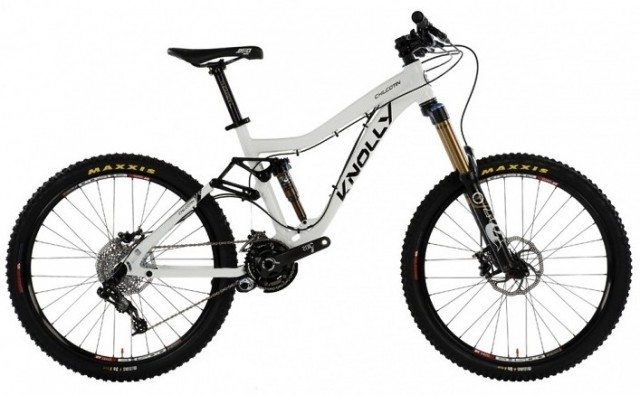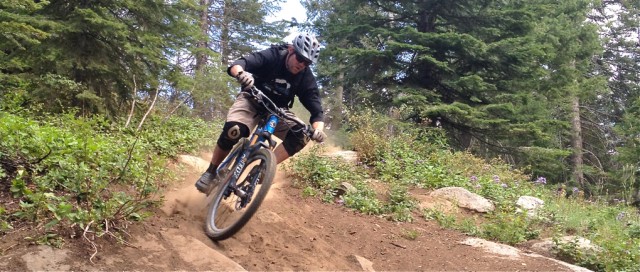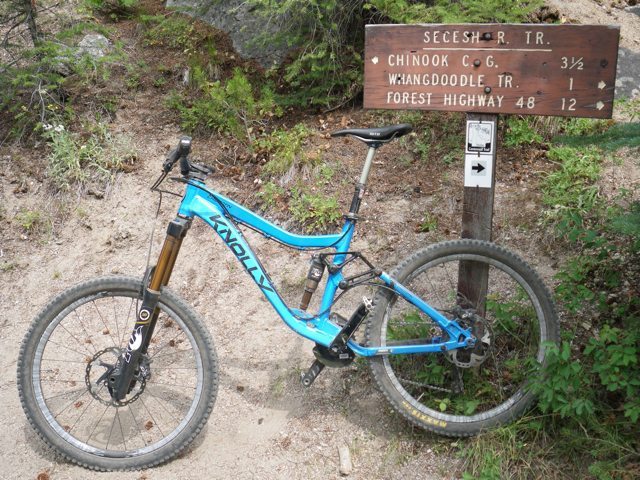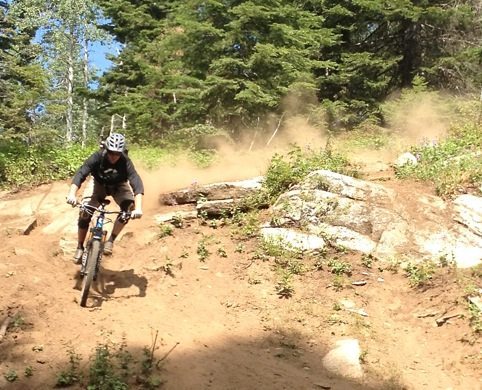
Bike: 2013 Knolly Chilcotin
Wheels: 26”
Size Tested: Medium (23.5” top tube)
Weight: ~30 lbs. (see The Build section for more details)
Geometry: Check it out here
Rider: 5’11”, 160 lbs.
Build:
- Fox Float CTD rear shock
- Fox Float 36 RC2 Fork (set at 170mm)
- Shimano XTR Drivetrain 1/10spd
- Gravity Light Cranks and Chainguide
- Shimano Saint Brakes (203/180mm rotors)
- 34t Chainring
- 11-36 cassette
MSRP: $1,995 (frame only w/ Fox Float CTD)
Duration of test: ~1.5 months
Locations: Mostly McCall, Idaho but a few trips to Missoula and Boise
[Editor’s Note: This review is a follow-up to a preview of the 2012 Knolly Chilcotin we ran last October. The 2013 frame is the same as the 2012 model, but Knolly now ships the Chilcotin with a new 3D machined rocker arm and the CS (climb switch) version of the Double Barrel rear shock.]
North Vancouver-based Knolly Bikes (pronounced Know-lee) has been creating high-performance suspension frames to tackle the trails around the North Shore and surrounding B.C. area since 2002.
The Chilcotin, Knolly’s “All-Mountain & Park Destroyer” introduced in 2011, has 160mm (6.3”) of rear wheel travel, adjustable geometry, and a burly physique.
Build & Comparisons
I stripped the build kit for my Chilcotin off my last bike, a 2013 Diamondback Scapegoat. As I mentioned in that review, Diamondback did an exceptional job picking parts for the Scapegoat, making it one of the best off-the-rack builds on the market in the all-mountain category. You can find a quick overview of the parts above.
For purposes of this review, I’ll be using the exact same components from the Scapegoat and will make direct comparisons between the Scapegoat and Chilcotin, including comparisons between suspension design/function and overall performance.

Features
First off, the Chilcotin has 26” wheels. In my opinion (and admittedly I have yet to experience the 650b craze), standard 26’rs are ideal for a bike designed to tackle the technical steeps and the hairball drops found around the North Shore.
Secondly, I like that the Chili is made of aluminum. I ride mountain bikes in mountains where there are rocks and trees and things that can demolish your equipment if you take a bad fall, and I can’t imagine using a plastic bike on these trails.
I trust aluminum because of its proven history and I appreciate the craftsmanship of the Chilcotin. Not enough can be said for how stunning the quality of Knolly bikes are in person… The medium painted frame weighs 7.5lbs with a Fox Float CTD.
But what really drew me to the Chilcotin is Knolly’s patented 4xFour suspension. The linkage looks similar to an FSR-style horst link—with the rear pivot placed on the chain stay near the rear axle. But there’s more to this suspension than an extra link (we’ll dive into that in a bit).
Geometry
The Chilcotin has simple, adjustable geometry that lets the rider choose between a modest 67o head angle with 13.8” bottom bracket height and a low-slack 66o head angle with 13.4” bottom bracket height.
Hitting the trails? Leave it steep. Heading to the chairlift? Loosen the bottom shock bolt, swing the shock into the lower position, re-tighten, and initiate shred sequence. To the best of my knowledge, the difference in geometry has no effect on the shock’s leverage ratio.
The straight, 1.5” head tube will accept a variety of fork options. As long as you find the right headset, you can run almost any fork that’s 180mm or less on this bike. I’m running a Fox Float 36 RC2 180 (internally set to 170mm) with a tapered steerer. The Chili comes with a naked head tube, giving riders the option of running external or internal cups to further alter head angle/stack height. I chose a Chris King I5 headset, with external bottom cup and internal upper.
There’s lots of tire clearance on this bike, not something I’m usually too concerned about. There’s plenty of room to accommodate large volume tires—I threw on a Continental Mountain King 2.4, which is similar to a Maxxis 2.5, and there’s still plenty of space between the stays. You can tell this bike was made to romp in wet conditions.

Cable Routing
The cable routing on the Knolly is intuitive. There are external housing guides on the top of the down tube and along the inside of the seat stays, which protects the rear derailleur and the brake from branches and the trail if you crash. Guides on the underside of the top tube hold the dropper post housing tight and clean, and a removable front derailleur cable stop tucked in beneath the rocker arm lets you run 2x or 3x.
I like the fact that Knolly stuck with a threaded bottom bracket shell and added replaceable ISCG 05 chain guide tabs to the frame. These tabs are a necessity with 1x setups becoming more popular, I think. Because the XTR Clutch rear mech works so well at keeping tension on the chain, I’m running the Gravity Light chainguide with the bottom idler arm removed.
Sizing
I was on the fence in deciding what size Chilcotin to ride. Using Knolly’s recommended sizing chart, I fall right between medium and large.
I decided on the medium primarily because of the jump in seat tube length—16.9” on the medium to 19” on the large. I’d rather have a bike that’s a tad small and have to change cockpit set-ups than fight a larger chassis. The large also has an extra inch in effective top tube length over the medium’s 23.5” (something worth considering for those with longer torsos than mine).

Fit
Knolly places the seat tube forward of the bottom bracket, a design that might look goofy at first, but it has its intended purpose.
Placing the seat tube forward of the bottom bracket positions the saddle forward and well out of the way when dropped for long descents. With remote-dropper posts becoming the norm these days, this concept performs flawlessly with my KS Lev, and I’ve never hooked a saddle nose on my shorts.
The effective 73o seat tube angle keeps the rider centered when climbing. The medium Chili fits me okay for climbs and long rides, given it’s on the smaller end of my preferred size range. I set up the cockpit with the leftover build from the Scapegoat—Easton Havoc 31” bars and 50mm stem, dropper post, and a WTB thinline saddle.
With this downhill-oriented set up, I do feel slightly cramped and have quite a bit of bend in my elbows. This hasn’t resulted in any sort of serious muscle strain, but I can feel the effects of these close quarters in my lower back after a solid climb.
I could toss on a 65-70mm stem, which would give me a little longer reach and make the cockpit feel a bit roomier. But overall, I don’t mind if the Chili feels a little tight on the ups since this setup gives me more precise handling on the downs.
NEXT PAGE: 4XFour Suspension

first time I’d ride tis bike, yess this bike needs more power to pedal for long way.
but when you found what kind of technic to pedal this bike, it become a beast on all kind of trails
very efficient, very stiff, smooth handling, you can push your own limits with no doubt
I am glad to have knolly’s bike